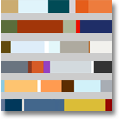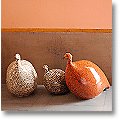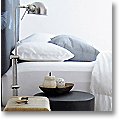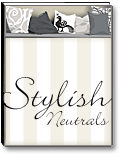Decorating Color Schemes Made Easy
How to create great decorating color schemes: 10 things you need to know.
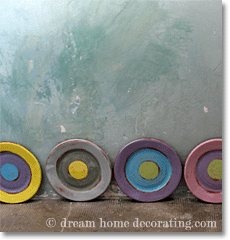
1. Will a color wheel chart
help me find an effective color scheme?
2. What are neutral colors, and how do I use them in an interior decorating color scheme?
3. Is there a system for selecting colour combinations?
4. Once I've got a color scheme idea, how do I choose the perfect paint color for my walls?
5. Do colors really influence how we feel?
6. Do colors have meanings?
7. Where do I start if I want to develop more confidence with color?
8. Where can I find ideas for new room color schemes?

9. Which bedroom decorating colors would work best in my home?
10. What books about color schemes would be useful to read?
1. "Will a color wheel chart
help me find an effective color scheme?"
A. Short Answer:
That depends on your needs. Basically, the color wheel can help you understand
- how colors relate to each other;
- how to identify complementary colors;
- which colors belong to one family.
There are color wheel charts that show
- shades (degrees of color mixed with black);
- tints/pastels (degrees of color mixed with white), or
- tones (degrees of color mixed with gray).
But a color wheel won't necessarily tell you which wall color would look great with your sofa. In other words, it can't create real decorating color schemes for you.
B. Long Answer:
a) All you need to know about the color wheel chart (and more ;-)
b) How to use a color wheel for interior design & painting
c) Understand primary colors
2. What are neutral colors,
and how do I use them
in an interior decorating color scheme?
A. Short Answer:
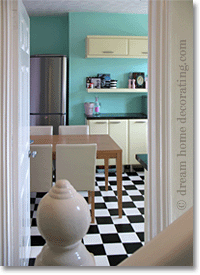
Genuine neutral colors are white, black, and any mixture
of these two, that is, all the different shades of gray.
Sometimes brown is seen in the neutral neighborhood as well, but strictly speaking, brown is not neutral. It is a mix of many different colors, among them yellow, orange, red, black, and green.
However, since most woods are a shade of brown, and much of our furniture is wooden, we are so used to seeing brown within decorating color schemes that it appears neutral to us.
Now to the second part of the question: Using neutrals in decorating color
schemes does require a special way of looking at your room.
You'll find more about this in the Long Answer!
B. Long Answers:
Check out this armload of information about
neutral
color palettes :-)
There's also a page specifically about neutral bedroom color schemes (with loads of pics): how to create drama, how to balance neutrals, how to play with warm and cool neutral colors. Oh, and have a look at 10 examples of neutral color schemes that work!
3. Is there a system for selecting color schemes?
A. Short Answer:
Yes. There are actually several possible methods, and your priorities determine which one works best for you.
a) Budget decorating color combinations: Start with items you will keep (expensive, large, special, difficult to replace, can't be hidden/painted), and choose colour combinations that go with these items.
b) Money-No-Object decorating color schemes: Pick the most hard-to-find, exquisite item (e.g. a fabulous rug or piece of art), and build your color scheme around this.
c) Choose A Mood, find colors that express a particular 'spirit' and then pick decorating color combinations that center on these colors.
B. Long Answer:
a) Interior
Design Colors 101: Step-by-step process to help you choose decorating color schemes,
whatever the limiting factors may be.
b) Great
Color Combinations: Pick whatever you find suitably stunning.
c) Choosing
Interior Paint Colors: How to know what colors you really like.
4. Once I've found a color scheme,
how do I choose the perfect paint color for my walls?
Short/Long Answer:
There's a proven process for this, and it involves loads of experimentation.
Because lighting (both natural and artificial) and surrounding colors are so important when choosing wall colors, it pays to be very deliberate and methodical. The page you want is Choosing Paint Color 101!
Return to Top5. Do colors really influence how we feel?
A. Short Answer:
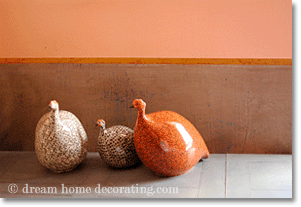
Definitely. And our emotions, in turn, affect our health, our
spending habits, and our responses to people and brands.
Color psychology is clearly on to some very important information ...
... however, the research is not clear-cut and simple; for example, there isn't just one color red, and different people respond to color in a variety of ways, depending on their personal history and cultural programming.
Long Answer:
a) Here's a link to more detailed information about using Color Psychology in decorating color schemes. This is still a very young science, so do treat its findings with some caution.
b) If you're interested, it's also worth having a look at the Psychological Effects of Specific Colors:
'neutral' colors - white, gray, black, brown
'warm' colors - yellow, orange, red, pink,
and 'cool' colors - purple, blue, green
6. Do Colors Have Meanings?
Short & Long Answer:
Only the ones we give them. But you can have a lot of fun with this - learn What Colors Mean in different cultures, and choose decorating color schemes that mean specific things to you :-)
Return to Top7. Where do I start if I want to
develop more confidence with color?
Long Answer #1:
First of all, relax - you're in good company! Many people would rather visit the dentist every week than think about decorating color schemes for their home. But chances are you just need some practice. You can definitely train your color sense!
Here's a little experiment - try it and see if it works for you:
Just for one day, set yourself the task of finding one color combination you really like. Just one color scheme. Once you've found one, you can either stop, or see if you can find an even better one.
Your color combination needs to be made up of
- at least two colors, (three makes it more interesting) or
- at least two hues of a color (for example, a bluish and a yellowish green), or
- at least two values (ex., a darker and a lighter green).
Whenever you see a color combination you like, ask yourself:
"What is it about this color scheme that makes it attractive?"
Even if you did nothing else, this question alone would develop your color sense more than you may think is possible. So just keep asking yourself that question with every attractive color combination you come across.
This way, while you're moving around (say, on your way to work, or while you're doing things around the house), you'll pay conscious attention to the colors around you.
Look closely at the colors of
- the sky
- the street
- people's clothes
- cars
- shop displays
- food labels
- plants
- your workspace
- your home.
Take notice of details - for example, the variations of gray in a gray sky (see if you can find the pink, blue, and yellowish/greenish hues):

Or, to give you another example: When you see something red, decide whether it is more on the yellow or more on the purple side (it can't be both).
Or see if the red has some white or light gray in it - that would produce a lighter, pinkish hue. It's always much easier to see when you have several hues of one color next to each other (so if you can't make up your mind about that red car on the road, don't worry!)

At the end of this day, you'll probably find that you're noticing colors much more than you did before.
If you keep going with this little exercise, you'll develop your eye for color and gain more and more confidence in your own color sense. You will find it easier to analyze the colors in your home and see what's needed to make your decorating color schemes work.
"That's all very well", I hear you say, "but how do I actually get from here to an interior decorating color scheme?"
Long Answer #2:
To understand the basics of creating an interior design color palette, have a look at the article about translating Paint Color Ideas into decorating color schemes!
Return to Top8. Where can I find cool new ideas
for decorating color schemes?
Short & Long Answer:
Everywhere. This is where the real fun starts! There's absolutely no end to the ways you can go about Finding Color Inspiration for a decorating color scheme. Click the link for a list of ideas. Enjoy!
Return to Top9. Which bedroom decorating color schemes
would work best for me?
Short Answer:
That depends on the mood you want to create and the ways you want to use this room. When space is at a premium, a bedroom might double as a home office, library, TV room, scientific laboratory, writing nook, ultimate fantasy space ... you name it, there's probably a bedroom been used (and color decorated) in this way.
Color schemes for bedrooms need to accommodate these multiple purposes, going easily from day use to night use, with bedroom paint schemes that look good at all times.
Long Answer:
Read more in the article about Bedroom Colors - it covers decorating color schemes for every major color under the sun, with loads of inspiring photos of gorgeous bedrooms.
I've recently added pages about Bedroom Color 'Styles' and Bedroom Wall Colors; with these, you get several versions of the same bedroom, plus loads of additional tips for choosing the right bedroom colors & paint schemes for your intended style. Check 'em out!
Return to Top10. Could you suggest a few color scheme books?
Here you go ...
-
Decorating Color Schemes, Room By Room:
Color Schemes For Bedrooms
More Bedroom Colour Schemes
Living Room Color Combinations
- How To Develop Decorating Color Schemes:
Interior Design Colors 101
(Step by step from empty room to finalized color concept)
Choosing Interior Paint Colors
(If you're not sure where to even start looking)
Choosing Paint Color 101 (How to get the walls right)
-
Find Color Ideas & Inspiration:
Decorating Color Scheme Ideas (Where to find them)
Paint Color Ideas (More research ideas, plus how to translate them into interior decorating color schemes
Great Color Combinations (A list of suggestions)
- Mediterranean Interior Design Colors:
Tuscan Colors
French Country Colors
French Country Decor & Color on a Shoestring
Provence Interiors & Colors
- Color Theory:
Color Psychology
Understanding the Color Wheel Chart
Basic Color Wheel: How to Use It
Guide to the Primary Color Wheel
Warm And Cool Colors
Monochromatic Color Schemes
What Colors Mean
- Neutral Color Schemes - The
Book:
Neutral color palettes make great decorating color schemes, but they're not as straightforward as many people think. Understand what makes neutral color schemes look their best, and what happens when you mix neutral color palettes with more saturate interior design colors. It's FREE!!
Yet to find the information you're looking for? Type a word or phrase into the search box below:

